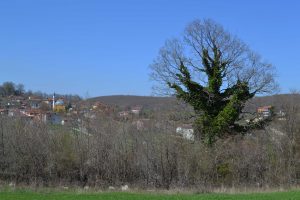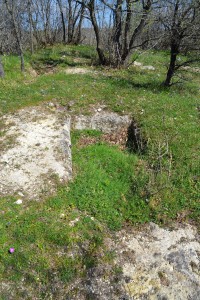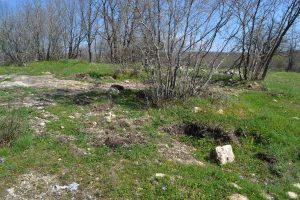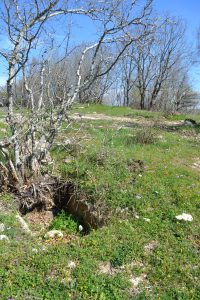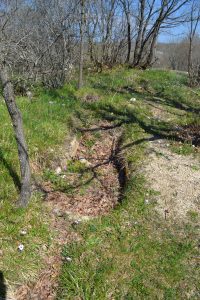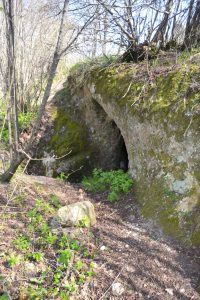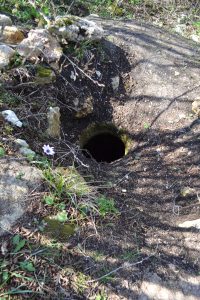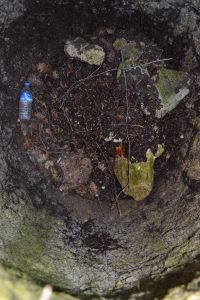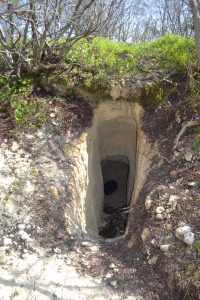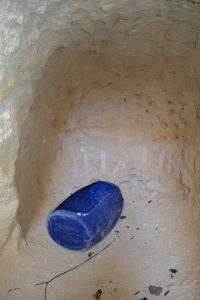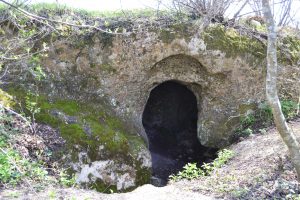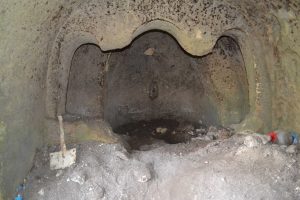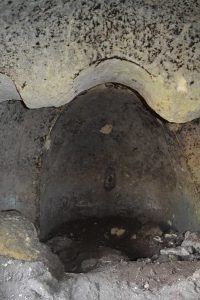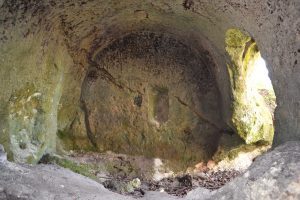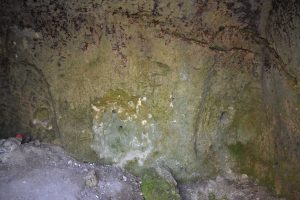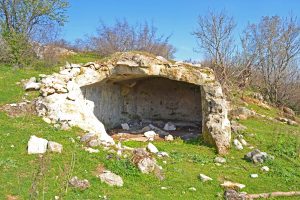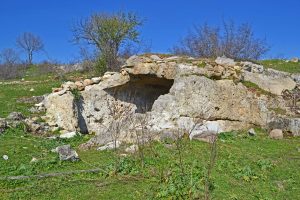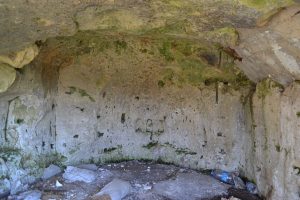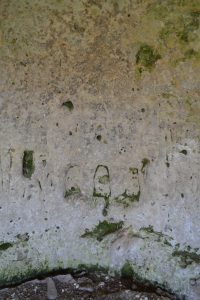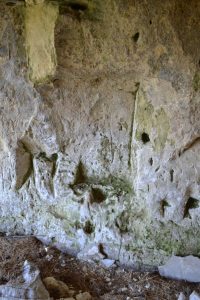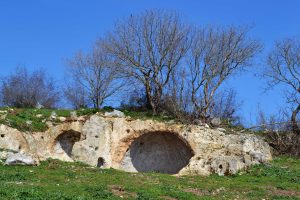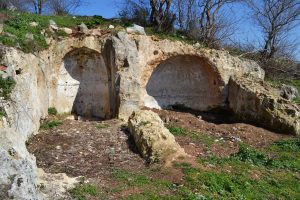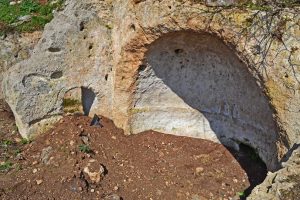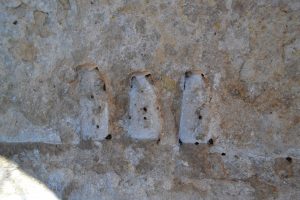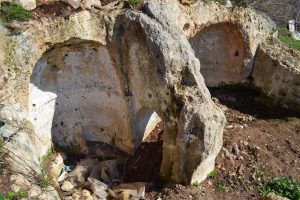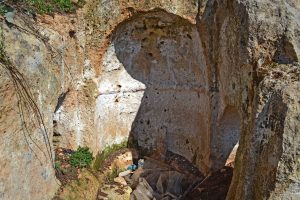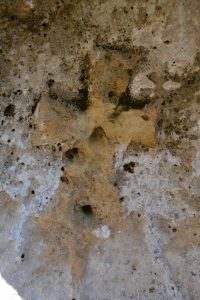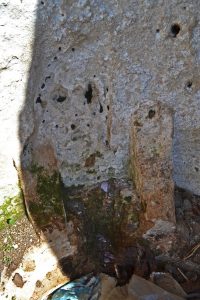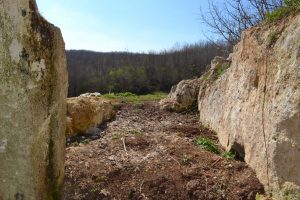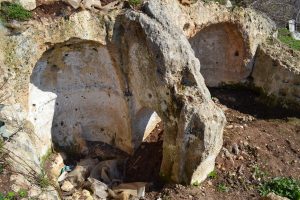Archive for January, 2017
Immediately to the north of Balkaya Church 3 is the outcrop of limestone into which the necropolis is carved. There are many rectangular tombs dug out of the rock. Most have been covered by the deposition of soil over time. Tombs are occasionally exposed after high winds such as those occurring over New Year 2016-2017. Trees growing in the shallow depressions cannot grow deep roots. When they blow over, they take a neat package of roots and soil with them, leaving the shape of the grave. No idea how many burials were carried out here. I guess we’ll have to wait for a hurricane.

Posted January 25, 2017 Posted by Adam in Uncategorized
Across the river from Balkaya village on a small plateau above the permanently waterlogged fields is an outcrop of rock that has been tunneled extensively by ecclesiastical Byzantines. The major remaining church (41.61059818995, 27.96443773317) is surrounded by rectangular tombs cut into the top of the rock. There are also small structures cut into the rock on either side.
The surface of the rock that was suitable for this sort of construction faces north. Immediately to the west of the church is one of the kaya küpleri characteristic of this limestone area. It is a 2.5 metre high stone jar cut into the rock and would have been ideal for food storage. To the east of the church is a chamber that has been excavated by treasure hunters. Its original conformation has been obliterated. The Kırklareli Envanteri site mentions two rooms here but they seem to have been knocked into one. Treasure hunters are now using generators and power tools to gouge through the rock and they do not bring a great deal of knowledge of the ancient buildings to their search. I fear for the future of this site and ones near it.
The church itself is entered through an elaborate opening in the rock. It is aligned on an east-west axis with the sanctuary on the eastern side. There was once an iconostasis carved to give the impression of three naves. This has been eroded so that the two dividing pillars are now gone but enough remains for the observer to visualise what must once have been a pretty little church. The apse is precisely carved and contains a niche in the centre. Chambers remain within the sanctuary that once served as prothesis and diaconicon.
The western end of the church is cut into a circular shape with a central niche. The southern wall has two niches. One contains a mortise which indicates that some, perhaps wooden, structure was attached. There is a small amount of graffiti cut into this surface.
It takes something of a feat of imagination to visualise this monastic community in action. Most of it has disappeared but the number of graves in the necropolis section shows that this area must have once been heavily populated with eccentric Byzantine dropouts from society.
Civelik, E. (2016) Balkaya Kült Alanı. Kırklareli Kültür Varlıkları Envanteri. Available online at: http://www.kirklarelienvanteri.gov.tr/sitler.php?id=130 Accessed 24th Jan 2017
Tanindi, O, Kurt, Ö. et al (2009): Archaeological Destruction in Turkey, Preliminary Report – Marmara Region Byzantine Period, TAY Project – Scientific Reports Series 16/Eng, Istanbul. Partially available at: http://www.tayproject.org/dosyabizmareng.html

Posted January 24, 2017 Posted by Adam in Uncategorized
Church 2 is about 50m south of church 1 (41.611040366748, 27.954626919524). It is a much more self-contained, angular affair with a rectangular cross-section. The thin slab of roof has fallen in some places and there are recent makeshift repairs with concrete. There is an apse shape carved into the eastern end of the building, with some details of the iconostasis remaining. These include the distinctive triplet of small niches, already noted in church 1. There is also a larger niche on the northern side of the apse. There was apparently a carved narthex (Civelik) but I saw little trace of this in 2016.
The TAY report of 2009 made complaints that the place was being damaged by its use as an animal shelter. Much more damage has been done by the ubiquitous treasure-hunters who, nonetheless do some of one’s digging for one so details can be seen at depth. There is a lot of earthenware debris outside.
Civelik, E. (2016) Balkaya Kayaya Oyma Kilise 2. Kırklareli Kültür Varlıkları Envanteri. Available online at: http://www.kirklarelienvanteri.gov.tr/anitlar.php?id=89 Accessed 24th Jan 2017
Tanindi, O, Kurt, Ö. et al (2009): Archaeological Destruction in Turkey, Preliminary Report – Marmara Region Byzantine Period, TAY Project – Scientific Reports Series 16/Eng, Istanbul. Partially available at: http://www.tayproject.org/dosyabizmareng.html

Posted January 24, 2017 Posted by Adam in Uncategorized
This church is surprisingly close to the main road through Balkaya. Entering from the west, there is a cleared area to the right of the road that is used for stacking wood from the surrounding coppiced forests before it is built into the charcoal-burning structures so common in the area. At the edge of this area is the church (41.611555404242, 27.954430482701), once used to shelter animals but now clear of debris and looking quite spectacular, as rock churches go.
It consists of a main church and a slightly smaller chapel separated from the larger nave by a wall about 60cm thick. The complex was cut from the rock in early Byzantine times but the roof fell in long ago. The well-defined main apse is distinguished by a triplet of small, shallow niches above the narrow sill about 50cm above current ground level.
A small doorway leads through the north wall to the chapel which has a very distinctive Maltese cross in relief in the semidome of the apse. There are some interesting features in the bottom of the centre of this apse – two supports, apparently for an altar, and a rudimentary face cut into the rock.
It’s a weird feeling being here. It must have been the centre of Isolationist Monk Central 1000 years ago. They chose a nice place with rich farmland, productive forest and fresh water not far away. There are a few tombs cut into the limestone nearby and the ground is littered with broken earthenware.
Civelik, E. (2017) Balkaya Kayaya Oyma Kilise 1. Kırklareli Kültür Varlıkları Envanteri. Available online at: http://www.kirklarelienvanteri.gov.tr/anitlar.php?id=86 Accessed 24th Jan 2017
Tanindi, O, Kurt, Ö. et al (2009): Archaeological Destruction in Turkey, Preliminary Report – Marmara Region Byzantine Period, TAY Project – Scientific Reports Series 16/Eng, Istanbul. Partially available at: http://www.tayproject.org/dosyabizmareng.html

